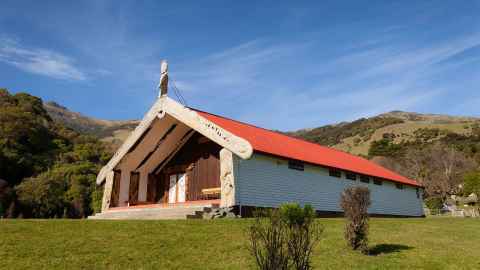Open your eyes to the future of Māori architecture
3 January 2020
Opinion: Māori construction is everywhere, all we need to do is open our eyes and our minds to include it in our city’s ever-evolving story, writes Deidre Brown.

My first critique session as a newly-minted architectural student was a disaster, albeit an influential one. The tutor berated me for incorporating Māori design into an early learning centre I presented. I was accused of cultural misappropriation. The culturally sensitive approach, I was told, was to leave Māori architecture on the marae where it belonged.
I took this as a provocation to incorporate Māori culture into as many projects as possible and with many supportive mentors, I later undertook a thesis on the architecture of Mōrehu movements. Mōrehu means survivor and is sometimes used to describe the followers of 19th and 20th century Māori prophets.
The Mōrehu movements established the social, political, spiritual and architectural infrastructure for tino rangatiratanga, or self-determination, before, during and after the New Zealand Wars. Before colonisation, Māori society was mainly organised as hapu and had distinct regional artistic and architectural practices. Through their resistance to colonisation and steadfast determination to hold on to their lands, Mōrehu movements sought the amalgamation of hapu and iwi into pan tribal and national groups. Some such as Pai Mārire mobilised to fight back, others like Paremata Māori or Māori Parliament movements created independent political systems or as the Rātana movement did, entered Parliament as MPs.
Leaders such as Te Whiti o Rongomai, Tohu Kākahi, Rua Kenana, Te Puea Herangi and Tahupotiki Ratana established their own autonomous towns on Māori-owned and contested lands. My doctorate identified about 300 Mōrehu buildings and associated structures from interviews, site visits, archived sound recordings, and primary pictorial and manuscript documents.
The thesis and publications that followed have demonstrated how the mana of movements shifted through the passing-on of symbols and architectural forms. And that the appropriation of Western-European design elements was not a sign of assimilation but a strengthening of culture against colonisation.
Architectural students and practitioners sometimes speak of Māori culture as something that has been buried underneath the city and propose projects that excavate it, like an archaeological dig.
The uniquely Māori arts associated with whare whakairo or decorated meeting houses that developed from the 1840s in Turanga, known today as Gisborne, are spread across the East Coast by the Ringatū movement (Te Tokanganui-a-Noho into the Waikato-Tainui region by Te Puea Herangi and the Turangawaewae Carving School and across the North Island by Sir Āpirana Ngata and his School of Māori Arts and Crafts).
As train and road networks grew, new ideas about Māori communal architecture spread across the country, with whare whakairo, only one of many styles. However, the focus of Ngata’s School on training experts empowered to teach the next generation of practitioners how to decorate meeting houses with whakairo rākau (wood carvings), kōwhaiwhai paintings and tukutuku panels, ensured that the whare whakairo became the predominant style.
Such was the success of the school that the whare whakairo and the marae on which they sit are regarded as the bastions, some would say the final bastions, of tikanga and te reo Māori around the country and, more recently, in urban centres
My journey has left me in no doubt that the only way to understand this country is to understand what happened during the nineteenth century. The New Zealand Wars had a devastating effect, extending far beyond the conflict zones, and has and will take centuries to repair. This is why the announcement that Aotearoa New Zealand history will become a compulsory school subject represents a transformative moment for our society. These history-empowered students will expect to see more of their living heritage reflected in our built and natural environments, and as architects, planners, urban designers and heritage consultants will be participants in the reconsideration, renewal and reconstruction of these places.
The suppression of this history has been a form of social conditioning that has made many New Zealanders blind to much of that which surrounds and affects them, including their built and natural environments.
Architectural students and practitioners sometimes speak of Māori culture as something that has been buried underneath the city and propose projects that excavate it, like an archaeological dig.
As I point out to them, we are surrounded in Tāmaki by 50 volcanic cones, some of which were fortified Māori pā that dwarf almost all of the city’s buildings and are still very much visible. Māori construction is everywhere, our culture and our ancestors surround us like korowai and all we need to do is open our eyes and our minds to see them and include them in a new chapter in our city’s ever-evolving story.
Professor Deidre Brown, Ngāpuhi, Ngāti Kahu is the first Māori Professor of Architecture at the University of Auckland.
This article reflects the opinion of the author and not necessarily the views of the University of Auckland.
Used with permission from Newsroom Open your eyes to the future of Māori architecture 3 January 2020.
Media queries
Alison Sims | Research Communications Editor
DDI 09 923 4953
Mob 021 249 0089
Email alison.sims@auckland.ac.nz